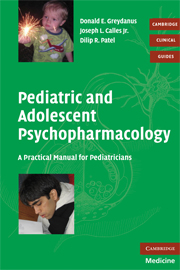Book contents
- Frontmatter
- Contents
- Contributors
- Foreword by Christopher K. Varley
- Foreword by Renée R. Jenkins
- Preface
- Acknowledgement
- 1 Principles of psychological management
- 2 The basics of pharmacology and neurotransmission
- 3 Basics of prescribing psychopharmacologic agents
- 4 Anxiety disorders
- 5 Attention deficit/hyperactivity disorder
- 6 Child and adolescent depression
- 7 Disruptive behavior and aggressive disorders
- 8 Schizophrenia in childhood and adolescence
- 9 Autism spectrum disorders
- 10 Psychotropic management of children and adolescents with cognitive–adaptive disabilities
- 11 Sleep disorders in children and adolescents
- 12 Tic disorders in children and adolescents
- 13 Substance abuse disorders
- Subject index
- References
2 - The basics of pharmacology and neurotransmission
Published online by Cambridge University Press: 18 December 2009
- Frontmatter
- Contents
- Contributors
- Foreword by Christopher K. Varley
- Foreword by Renée R. Jenkins
- Preface
- Acknowledgement
- 1 Principles of psychological management
- 2 The basics of pharmacology and neurotransmission
- 3 Basics of prescribing psychopharmacologic agents
- 4 Anxiety disorders
- 5 Attention deficit/hyperactivity disorder
- 6 Child and adolescent depression
- 7 Disruptive behavior and aggressive disorders
- 8 Schizophrenia in childhood and adolescence
- 9 Autism spectrum disorders
- 10 Psychotropic management of children and adolescents with cognitive–adaptive disabilities
- 11 Sleep disorders in children and adolescents
- 12 Tic disorders in children and adolescents
- 13 Substance abuse disorders
- Subject index
- References
Summary
This chapter reviews basic concepts of pharmacology and neurotransmission applicable to psychotherapeutic agents used for the treatment of mental disorders of children and adolescents. An understanding of the basic principles of pharmacokinetics and pharmacodynamics of drugs is important in the appropriate therapeutic use of various drugs.
In simple terms the effects of the body on the drug once it has entered the body has been referred to as pharmacokinetics, and it aims to provide a quantitative assessment of the main processes involved in the biodisposition of the drug which include absorption, distribution, metabolism, and elimination. On the other hand, pharmacodynamics concerns itself with the effects of the drug on the body and the main processes involved are the action of the drug on specific sites, especially the receptors.
Pharmacokinetics
Absorption
A drug can be administered via various routes and the specific route chosen largely depends upon the urgency to achieve the desired effect in a given clinical circumstance. In our review of pediatric psychopharmacology we are mainly concerned with the oral route. Once ingested the drug is absorbed from the gastrointestinal tract. The extent of drug absorption is influenced by the surface area available for drug absorption, and local blood flow. In addition the absorption also depends on the characteristics of the drug itself such as its water solubility, dosage form, or concentration. Orally ingested drugs will undergo the first-pass effect before reaching the circulation (see below).
- Type
- Chapter
- Information
- Pediatric and Adolescent PsychopharmacologyA Practical Manual for Pediatricians, pp. 25 - 48Publisher: Cambridge University PressPrint publication year: 2008

